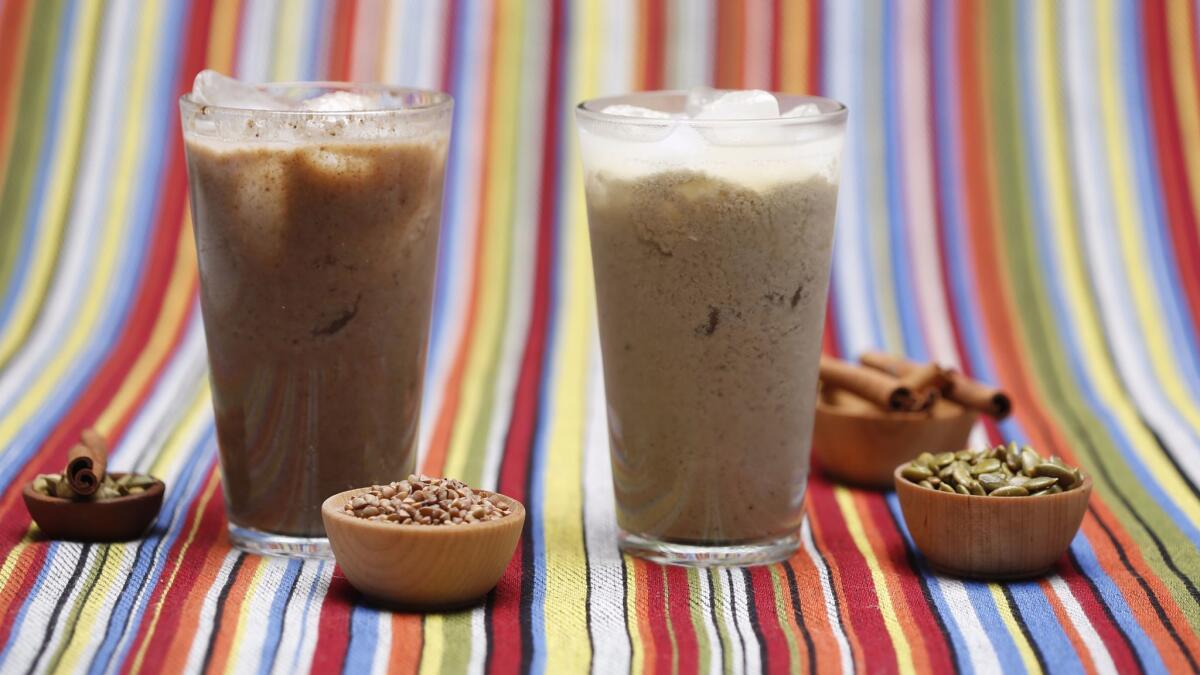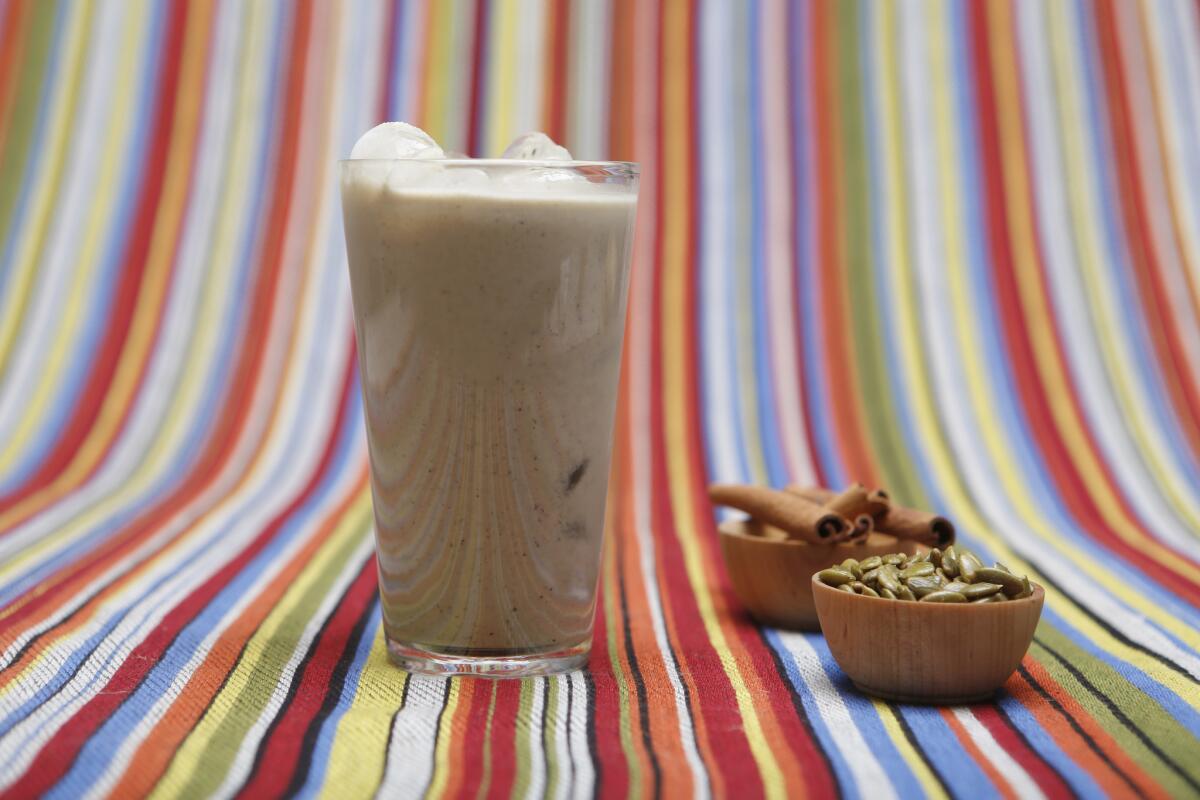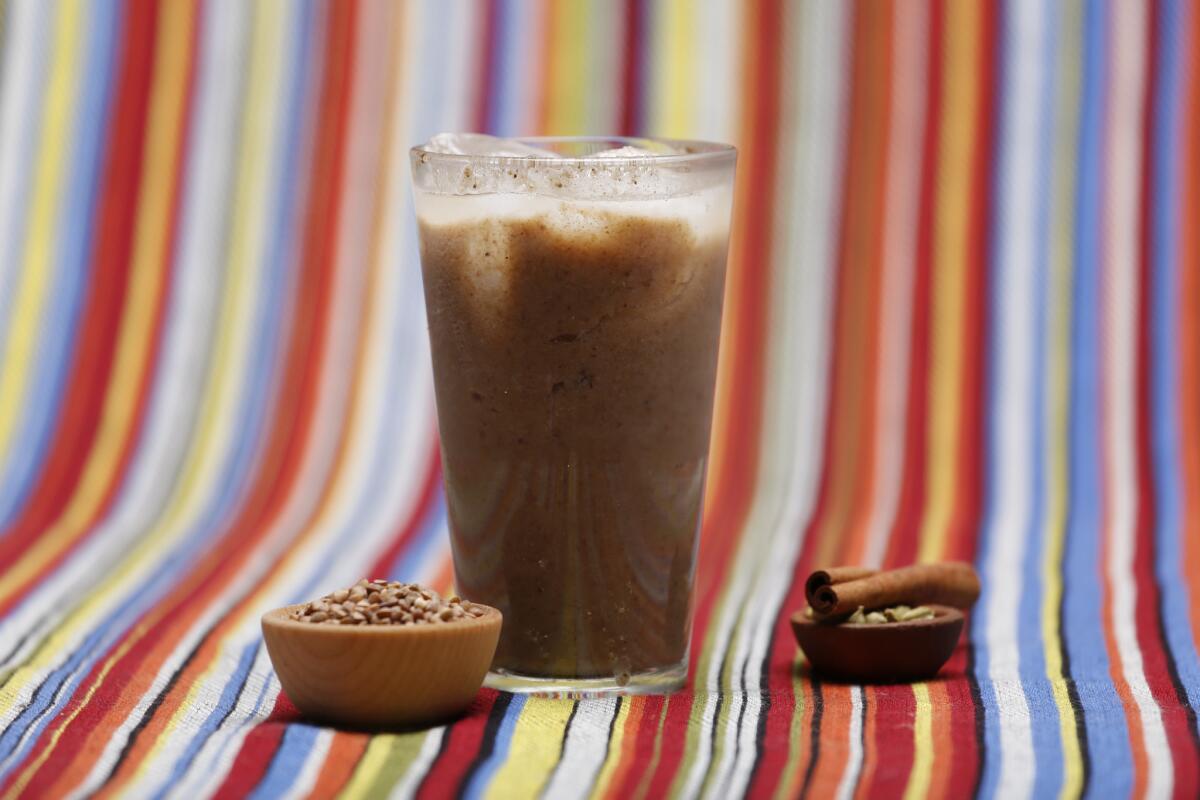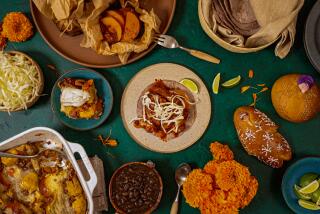Your glass of horchata can be a lot more mysterious than you think

- Share via
A perfect summertime drink, horchata — most familiar as the sweetened, slightly gritty iced beverage found at taquerias — is wildly popular throughout Puerto Rico, Central America and central and southern Mexico through the Yucatan Peninsula. In the U.S., the Mexican style of horchata predominates, made from rice that is soaked, ground, pulverized, strained and dressed up in sweet and sometimes spice-y accessories, most often cinnamon. Think of it as the original alt-milk.
At Guelaguetza, arguably L.A.’s premier horchata destination, the drink is its No. 1 seller and has been on the menu since the restaurant first opened in 1994. The Lopez family honors the Oaxacan style of the drink by serving it con tuna y nuez, that is to say, as a drink made of rice and cinnamon, with prickly pear puree, melon chunks and nuts.
“There isn’t a wrong or right way to make horchata,” says Guelaguetza co-owner Elizabeth Lopez. “Some people have the perception of horchata as being a very sweet and milky drink, while others think of it as a refreshing and light refreshment.”
Indeed, in addition to rice, horchatas can also be made from almonds or other nuts, grains, even seeds like pumpkin or sesame.
Latin American horchatas are actually an interpretation of a much older drink (the original horchata) from Valencia, Spain, which is made not from a grain or a nut but rather local nut-like tubers called chufas or tigernuts. Horchata also has a culinary (and etymological) cousin in orgeat, the almond-based syrup used in Mai Tais and other cocktails. Even further back, the ancient ancestor and eponym (based on the Latin word hordeum for barley) of both horchata and orgeat is barley water, the zeitgeisty au courant drink of 600 BC, made by soaking, grinding and straining barley grains.

Recipe: Pumpkin seed horchata »
Casilda Flores Morales, the late Oaxacan horchata matriarch, earned the epithet “empress of refreshment, the heiress of the alchemy and secrets of almond, chilacayota and chia.”
Horchatas are straightforward to make and an excellent canvas for refreshing experimentation. Consider the almondy neo-horchata-plus-cold-brew beverage called Horchoffee at Jessica Koslow’s East Hollywood toast shop Sqirl. What connects all these diverse horchatas, and can help you attain empress-of-refreshment skills yourself, are the phenomena of extraction and suspension.
Horchata manages to be creamy without containing any milk or cream. Creaminess, as fans of almond milk and coconut yogurt are aware, doesn’t actually require dairy, but rather the thickening effect of having large molecules of starch, protein and/or fat suspended in a background of water.
On a molecular level, horchata-making is about grinding, soaking and blending rice, almonds, seeds, chufas, etc. to encourage their fat, starch and/or protein molecules to migrate into the water you’re blending them with, and to float there as a thickened, milky-creamy mixture known as a suspension. Suspensions with especially tiny particles, like horchatas, will remain in this floating, opacified, viscous state indefinitely.
Starch, protein and fats each interact with water a little differently, leading to differences in the suspensions they form. This means that the texture of a given horchata will vary depending on its base ingredient. Fat molecules, in their pure state, are loath to mix with water and will separate into distinct layers like a broken vinaigrette.
The fats in nuts and seeds, however, are fitted with tiny coats of protein, which is much happier to mix with water. These coated fat droplets, known as oil bodies, create an especially thick mixture called an emulsion. Fatty seeds and kernels will make the creamiest horchatas — almond, sesame and squash seeds are all traditional examples.

Recipe: Buckwheat cardamom horchata »
Starches are the main agent in Oaxacan, Valencian and other grain- and tuber-based horchatas. Free starch molecules will mix with and thicken water, but inside the plant parts that make starches, like grains of rice, the molecules are glued and laminated together into aggregates called starch granules. These granules will grab onto water and swell up a bit but won’t unspool except at high temperatures. In starchy horchatas, the starch grains are detectable on the tongue; so a rice (or barley or other grains with which you choose to experiment) horchata will always be a little grittier, a little less creamy, and more likely to settle out than one based on fattier nuts or seeds.
A word of warning: Heat helps speed up extraction and can be quite useful for efficient horchata-making. But while almonds and seeds can stand up to near-boiling temperatures, overheat a starchy horchata and you’ll unspool the starch granules completely resulting in horchata-flavored glue (ask me how I know!). To be safe, stick to water temperatures below 140 degrees Fahrenheit.
Horchata can be made from almost any seed, grain and nut product, not just rice. Here are two recipes to get your creative horchata juices flowing. The first one is inspired by a less-famous Mexican style of horchata made using indigenous squash seeds. It behaves a bit like an almond milk, has a lovely light green color, and can be adapted to use other nuts and seeds like peanuts and sesame. The second is totally untraditional but inspired by the ancestor of horchata, barley water. Buckwheat, a starchy grain-like pseudo-cereal, lends a flavor that whispers of soba noodles and buckwheat tea.
Johnson was the resident scientist at Noma in Copenhagen and is now a researcher at the MIT Media Lab in Cambridge, Mass. She holds a PhD in flavor chemistry.
To read the article in Spanish, click here
More to Read
Eat your way across L.A.
Get our weekly Tasting Notes newsletter for reviews, news and more.
You may occasionally receive promotional content from the Los Angeles Times.










